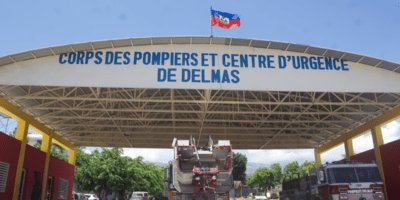Two days after the announcement of the re-emergence of cholera in Decayette, the municipality does not seem to be concerned by the disease.
The girl from the Savane Pistache locality was vomiting. Her legs were no longer strong enough to support her.
On the morning of Thursday, September 29, 2022, her parents decided to take her to a prayer group.
Some neighbors objected. At their request, the 15-year-old child, visibly dehydrated, was taken to the Decayette Community Health Center, said Faustin Philter, head of the facility.
However, this was not the end of the road. Without medical equipment, drugs, serum, etc., the center with its only nurse could not take care of the patient.
At their request, the 15-year-old child, visibly dehydrated, was taken to the Decayette Community Health Center, said Faustin Philter, head of the facility.
“We called Doctors Without Borders/Médecins Sans Frontières (MSF),” explained Faustin Philter. Because of the road blocks erected by the gangs, the patient was transported to MSF on a motorcycle, said the director, who would not reveal the identity of the patient.
Two days later, the Ministry of Public Health and Population (MSPP) confirmed the presence of cholera in Savane Pistache (Decayette) and in the Brooklyn neighborhood of Cité Soleil.
The disease was introduced to Haiti in 2010 by Nepalese soldiers from a United Nations convoy.
Read also : CholeraGate: the earthquake, the climate and the environment were good excuses
In February of this year, the MSPP held a ceremony to celebrate the official eradication of cholera in Haiti. The last confirmed case, before this sudden re-emergence, dated February 2019.
“Now, the emergency services of the MSPP are being reactivated to find the causes of the new emergence in the identified households,” confides Dr. Lauré Adrien, Director General of the MSPP.
An expert well implicated in the fight against infectious diseases shares with AyiboPost three hypotheses to explain the recent cases of cholera in Haiti. The first is that the bacterium is present in the environment. A mutation of non-toxigenic vibrios, although unlikely, cannot be excluded. Second, the disease may have been reintroduced voluntarily or involuntarily. A flaw in the monitoring system put in place after 2010 cannot be ruled out either.
The disease was introduced to Haiti in 2010 by Nepalese soldiers from a United Nations convoy.
Other factors seem to have played a part. According to the expert, who requires anonymity to avoid political consequences, donors and health officials in Haiti completely neglected community-based care after 2010, which includes investments in sanitation. Instead, they focused on cholera treatment centers for “advertising” reasons.
“Haiti remains a vulnerable country, even after cholera has been eliminated,” due to the problem of access to clean water and the lack of a good health infrastructure. Low immunization coverage against measles, polio, and neonatal tetanus also puts Haiti at risk for a re-emergence of these diseases.
In Savane Pistache of Decayette, the population is not worried, remarked AyiboPost on Monday, October 3, 2022. There are no hand-washing stations or awareness campaigns in the locality.
“I was informed of the new confirmed case this morning, on a radio station, says Raphaël Bristol, a well-known figure in Savane Pistache. I was a little shocked to learn that it had been identified in my area.”
“Now, the emergency services of the MSPP are being reactivated to find the causes of the new emergence in the identified households,” confides Dr. Lauré Adrien, Director General of the MSPP.
The community is currently facing a serious shortage of drinking water. “Since the beginning of the socio-political unrest in the country, the trucks can no longer bring us water, complains Raphaël Bristol. This situation has increased the price of a water container to 35 gourdes. The five gallon bottle of water treated by reverse osmosis sold in the stores costs between 100 and 125 gourdes,” he says.
Cléenta, a merchant at the Savane Pistache market, nods. “Waste is rarely collected, and the area has become very dusty due to the degradation and overuse of the main road,” she adds.
Because of the insecurity in Martissant, traffic in Savane Pistache has increased. Passersby use the “Ti kajou” road to go to Carrefour and other cities in the south of the country.
Because of the insecurity in Martissant, traffic in Savane Pistache has increased.
The Pan American Health Organization (PAHO) reports the confirmation of two cases of cholera in Haiti. Seven deaths and twenty suspected cases are being tested.
On October 3rd, Doctors without borders admitted 68 patients to its facilities in Brooklyn (Cité Soleil) and Turgeau. Among these patients, a three-year-old child died.
MSF has opened a 10-bed cholera treatment center (CTC) in the Brooklyn neighborhood, a 20-bed CTC at MSF’s emergency center in Turgeau, and a 50-bed CTC at MSF’s Cité Soleil hospital, as well as several oral rehydration solution (ORS) distribution points.
Seven deaths and twenty suspected cases are being tested.
The CTC in Cité Soleil is ready to receive new cholera patients, while the other units have already reached their limit, according to the organization’s website.
In a statement released on October 5th, the United Nations said it is ready to mobilize emergency response teams to support affected communities as soon as safe access is assured and fuel supplies are provided.
According to the director of the Savane Pistache health center, Faustin Philter, the little girl’s condition was stabilized. She returned home following medical intervention.
Widlore Mérancourt participated in this report.
English translation by Didenique Jocelyn and Sarah Jean.
Cover photo : © Thony Bélizaire/AFP







Comments